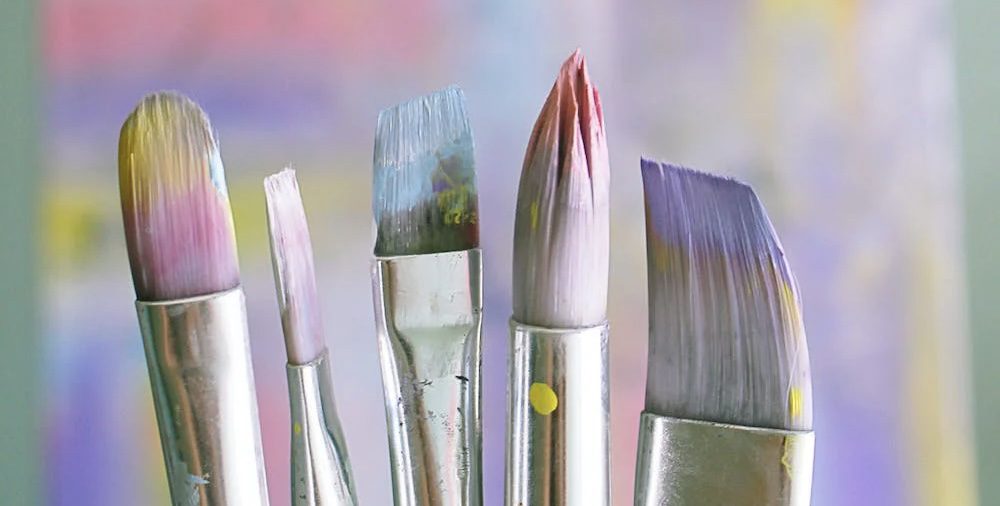Primarily, I paint my portraits with oil paint. This is because I am very familiar with the consistency. However, If you use acrylic paints, it’s important to understand some distinctions in how the medium functions and how to make acrylic portraits to your advantage.
Painting portraits is a skill that most artists should have. Some of the most famous paintings in the world are portraits from artists. For example, the Mona Lisa by Leonardo DaVinci. Or, even self portraits! Like Van Goghs “Self Portrait With Bandaged Ear”.
Read about how to make a mini portrait with oil paint here.
Make sure you have what you need
When you are painting with acrylic paint, there are only a few things you will need. Paintbrushes, a mixing palette, and a cup of some water. Acrylic paint is water soluble and this is how you can clean your brushes and thin the painting mixture.

Tip #1: Make an underpainting
It doesnt matter if you decide to just simply paint with a base color on your canvas. Make sure that you have the canvas covered in a color! You can even just do a simple wash, such as the imprimatura technique.
You will want to do this because of acrylic paints consistency. Since it is fast drying, it becomes more difficult to mix the exact color you had before if you need to fill in a small section that was left white that you hadn’t noticed before. Painting the base of your canvas will solve this problem.
Tip #2: Use white paint to your advantage
White paint, specifically titanium white, has the thickest and most opaque consistency of any of the hues used in acrylic paint. Unless you are desiring a quite thin consistency, white will help to thicken up your paint and make it less transparent.
Make sure you do not use too much though if you are going for a darker value in your color. I advise using it in very small amounts and gradually adding to see how much it will affect the value. It’s also important to remember that acrylic paint dries darker then when it is wet!
Tip #3: Prep by blocking out your shadows
After you have made an undertone, blocking out the shadows with a darker color will help you begin to have contrast. With acrylic paint in particular, mapping out the space is important for how fast drying the paint itself if.
Tip #4: Start with mid-tones
When I am making acrylic portraits, i want to focus on getting a base color for the skin tone. You will want this to be the middle ground between your darkest areas and your lightest on the face.
Having a mid-tone will help you begin to understand where there is dimension in value of the face. It is much like blocking out a smaller underpainting for the subject of the painting.
Acrylic painting is often just a process of focusing on certain patterns until you reach smaller and smaller spaces.
Tip #5: Focus on the end result
With acrylic painting, it can be hard to see where your vision is going with solid shapes that do not have any dimension! As long as you focus on small parts of the canvas and add details to just bits, it will work like a puzzle. If you try to look at the bigger picture all together, you can confuse yourself or develop artists block.
Tip #6: Only squeeze out small amounts of paint
Acrylic paint is really easy to over mix. When I am painting with acrylics, I tend to squeeze out larger amounts that then not only dry fast, but are mixed and dont make the color I want. Then, I have to squeeze out more paint, and the problem continues. If you only work with very small dollop size amounts of paint, and mix those, you will not waste as much paint.
Not only will you not waste, but you will familiarize yourself with the measurements and propositions of each colors to mix a new hue.
Tip #7: Add your highlights last
It is really easy to mix colors that end up being a different color than you intended. This is because acrylic paint dries darker. If you adjust to the drying tendencies, then you can add highlights gradually.
It’s also important to remember that no whites in a picture are truly white. Work your way up, with the under-tones in a color, to the brightest part of the color to get the right color and complexion.
Tip #8: Do not be afraid of color!
Acrylic paint is so great partially because of how vibrant and pigmented it lays! Skin has more than just neutral tones, but it can have blue or purple shadows, flushed cheeks, and yellow highlights. Focus on a color palette in the skin that explores how undertones affect the perception of the skin.


Comments are closed.